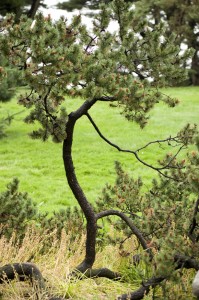Replica (and Not)
Posted in Around the Garden on November 8 2011, by Paul Lisicky
| Paul Lisicky is the author of Lawnboy, Famous Builder, and The Burning House. His next book, Unbuilt Projects, is forthcoming. A New York City resident, he is a contributing member of the NYBG’s literary audio tours program, an opportunity for talented writers to add a touch of poetry to the exploration of the Garden. |
 The sandy soil, the boggy ponds: whenever I feel an inexplicable sense of geographic safety (say, in parts of Cape Cod, coastal North Carolina, or Florida), I understand soon enough that I’m looking at a replica of my childhood backyard–or at least the woods and marshes nearby.
The sandy soil, the boggy ponds: whenever I feel an inexplicable sense of geographic safety (say, in parts of Cape Cod, coastal North Carolina, or Florida), I understand soon enough that I’m looking at a replica of my childhood backyard–or at least the woods and marshes nearby.
And yet I once wanted to be elsewhere. Or at least I wanted my plants and trees to be elsewhere. I wanted them to grow in unexpected shapes, leaves large as shovels. I wanted them to be a little scary, a little closer to life as I knew it, which felt to me both beautiful and a little brutal. (Don’t children always know that consciousness is darker than their parents remember?) On childhood trips to Florida or California, my eye went first to the plants. The plants in warmer climates weren’t bound to restraint or to the pressures of some unnameable force, the codes always changing, impossible to decipher. Their oranges could be brighter; their trunks could be thicker, their vines could grow and twist until they made a mess of themselves, until you had no idea that the plant had once been a beautiful thing.
The Swiss mountain pine, the plant that stirred my attention, struck me as one of those exotics when I first saw it last spring. Only later did I realize that the plant was something else. I’d pictured it growing on the hot slopes of Greece, the foothills of the Catalinas north of Tucson. In actuality, the Swiss mountain pine is a giant version of the sweet, benign mugo pines that my parents had planted decades ago, around the paper birches and cedar diadaras in their Southern New Jersey yard. As much as I liked our Mugo pines, ours were no wider than basketballs. Here something familiar had gone large, stark, and mysterious, and maybe that was why my spine straightened when I first saw its crooked branches. Two contradictions fused: my childhood home, and my incessant longing for other.
Ed. note: If you’d like to see more from our literary audio tour contributors, be sure to view Hosannah Asuncion’s “Tasseography,” as well as “Rose Hopscotch” by Ana Božicevic.

